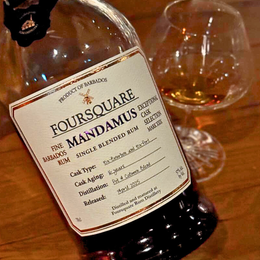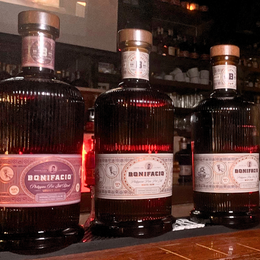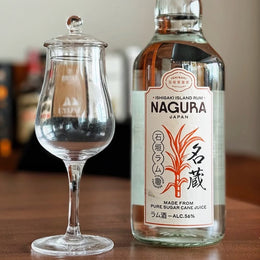Editor's note: This is Part 2 of Jigs' 3-part series on Luisita Rum. Jigs interviews Paco Cojuangco, Luisita Rum's "Farmer Behind the Brand" about the brand's fascinating history, production process, philosophy on rum and the future plans of Luisita, and he also reviews three bottles of Luisita's rums. This second part focuses on the brand's production process. Read Part 1 here and Part 3 here.

“[Luisita] is where we and the rum are from, and we wanted to emphasize the community and our traditions – we threw in all those elements in the bottle, from the liquid to the packaging.”
In my previous review, I shared the first part of my conversation with Paco Cojuangco, Luisita Rum’s “Farmer Behind the Brand.” Today, our chat takes us to the brand’s production process. As you’ll see, Paco shares an immense amount of detail to take us through how Luisita makes its rum.

[Jigs]: Tell us about how the estate produces sugarcane. What happens throughout the process, from choosing the cane varieties to when and how they are harvested?
[Paco]: Sugarcane production involves a 12-to-14-month crop rotation here in Tarlac and in the Philippines, in general. While we somewhat consider the quality of sugarcane varieties, including factors like the amount of fiber and juice purity, we select varieties based more on growing conditions rather than varietal constraints or influence. At any given time, we are officially growing 10 varieties, and after about 7-10 years, we replenish and bring in new varieties, which is done through the SRA (Sugar Regulatory Administration), a sub-department under the Philippine Department of Agriculture. We are not looking at it from a rum perspective; varieties are selected based on which will be most profitable for the famer. That, obviously, translates to higher quality sugarcane and sugarcane juice. For the molasses we use for Luisita, we choose specific varieties that have the highest sugar content once they ripen.
After the growing period comes the harvest. Sugarcane is actually just taken care of from the time it is planted up until the fourth or fifth month because at that point, tractors are no longer able to enter the fields. Carabaos, smaller tractors, and people on foot can be used, but after seven to eight months, the sugarcane stalks will get really heavy and fall. We take care of it but, eventually, just watch it grow. Of course, while sugarcane grows in some fields, we plant new sugarcane or harvest sugarcane in other fields. Traditionally, cutting is done by hand by people called sakadas or tabaqueros, and we still have that in Luisita. In 2014, that was my first role here; I joined a pangkat (or team) and cut and carried sugarcane. However, the advocacy of my father and his business partner was to mechanize these jobs using sugarcane harvesters. We divert the people to jobs like spot weeding, tractor operation, or nursery work that cannot be done by machines. Luisita has always been at the forefront of mechanical harvesters. Some people say that hand-cut sugarcane tastes better, but we don’t do that with Luisita because our rum is currently molasses-based. If we were to get into making a style similar to agricole, maybe hand-cutting sugarcane is something I would do.

[Jigs]: What process and equipment do you use for pressing the cane? How do you process the juice afterward?
[Paco]: The harvested sugarcane is dumped into the mill using old trucks that were used in the war. The six mills we use are the same that have been used since 1928; each mill has three rollers: one top roller and two bottom rollers. The fiber that is left after the juice is extracted becomes the bagasse that we use to fire up the boilers for the mill. To avoid throwing up ash into the air, we installed scrubbers that shoot water at the smokestack that collect particulates like mill ash, which is a good source of potassium that we then return to the farm. We’re not connected to the grid and are not getting any energy; it’s a closed-loop system.
The sugarcane juice then goes to the boiling house. Through steam from the boiler, the juice is cooked to evaporate the water and bring up the brix [a unit of measurement used for dissolved solids in liquid, typically dissolved sugar], and then the cooked syrup is sent to the centrifuge. At the start of each year, one sugar crystal is made and dropped into a centrifuge – think of it like the production of cotton candy that turns sugar crystals into big strands. The cooked juice or syrup is spun in the centrifuge, causing it to crystallize as extracted sugar. You can do this multiple times, and the final product that still has sugars but can no longer be crystallized is the blackstrap molasses. For our rum, though, we don’t use blackstrap molasses because we want to use molasses with more fermentable sugars, so we use other grades of molasses: A, B, and refinery molasses. We make the blend and send into the distillery for fermentation whatever we find tastes good – there’s no fanciness to it.

[Jigs]: What types of fermentation are currently used for Luisita rum? What kinds of yeasts and what temperature are used? How long is fermentation?
[Paco]: The fermentation facility comprises 800,000-liter enclosed fermentation vats. The current releases aren’t made with open fermentation – yet. We also don’t use wild yeast; we use a strain that’s been with us since, probably, the 80s. That was the last time we got a receipt from University of the Philippines Los Baños, which supplies yeast in the Philippines after sourcing from overseas, including other universities and the Canadian company Lallemand. Based on the receipt, the yeast is just your basic brewer’s yeast or Y2 strain. Interestingly, every time there was a good production year in terms of efficiency, the distillery men and women (we don’t call anyone master distillers) would get from the finished fermenter and put it back in the system. I guess this practice stems from the local knowledge in breeding fighting cocks; they probably figured that they can keep improving the yeast genetics that way. To avoid losing the strain of yeast we use, we keep the yeast in four locations: one in the mill, one in the lab, one in my house, and one in a fourth location unknown to me.
We like to keep fermentation of at least 30 degrees Celcius because that’s where the yeast is active. The fermentation times range anywhere between 22 and 26 hours, depending on the brix and TSAI (total sugars as invert) readings. As those readings go down, they plateau, showing that the yeast has finished doing its thing. Lots of people talk about longer fermentation times, especially the Jamaicans who are known for their signature funky style, so we tried pushing fermentation longer to see what happens, and it seems that there isn’t much of an effect when using a closed fermentation system. Recently, steam pressure issues in the mill resulted in a fermentation tank going for 30 hours; I tried it, but I think it came off a little too funky, perhaps because it might not be the proper way to execute long fermentation. It had unique yet rancid flavors and was no longer pleasant. Given all of this data, it seems that with our current setup, longer fermentation times are not possible unless we use alternatives like open fermentation.

[Jigs]: What kinds of stills do you use? Tell us about the distillation process.
[Paco]: We use a copper twin column still, each containing about 30 to 35 plates. We have a beer column, a purifier or aldehyde column in the middle, then the rectifier. Right after fermentation, the beer comes off at about 7-8% ABV, and this is fed into the beer still, where the beer is met with steam at the bottom that comes from the boiling house. Through temperature, it fractionates at different levels and different plates. In the beer column, the temperature is very high, so we already get a lot of the “tails,” though this term is more accurate for when using pot stills. The aldehyde column and condenser help capture some tails and heads. In the rectifier, at about the 60th plate, we get the fine alcohol, which is at 78 degrees Celcius; we use probes to measure where that temperature is, and that’s where we get the rectified alcohol. It’s always been like this; we’re just getting the fine alcohol.
However, when we got into rum, we were introduced to propanol and methyl-acetate – congeners. We started seeing if we can find these in our distillate. We learned that the distilling setup of Saint Lucia Distillers is similar to ours because they use a column still, but they talk about producing four kinds of rum. This got me thinking, and it turns out that you can stick a pipe at each plate and see what comes out. So we invested in a gas chromatograph to tell us about the alcohol from different plates in our still. I kid you not: I have 70 pipes; I punctured every plate and tried the distillate. That’s now how we make the rum, and we’ve been doing this since 2020. None of the new-make is out in the market yet. It’s still a column distillate that’s light, but there’s much more to it. Some distillates from some locations, however, are not that palatable, whether because of having too much heads or tails.
Right now, we have at least three marques that we take from three separate points of the still. It changes because it’s always about location when it comes to column stills. This is why we always have a tasting team whenever we operate; sometimes, the marques we want might move to different plates. It’s a game of hide-and-seek with the column. It’s fun! Ever since we did that, our mindset changed because there are so many more flavors available. Column stills are so underrated. We run the still for about two to three weeks in a season of production, which is what we need so far, and then we stop.

[Jigs]: What general approach does the brand take in terms of maturation? How does that approach change for the brand’s different expressions?
[Paco]: With choosing what distillate to put into the barrels, I still believe in what our original consultant taught us, which is to stick with our unique tradition and heritage. He found that the Luisita style, which we don’t want to lose, has notes of brown sugar, overripe or candied banana, and citrus pith. I always look for those flavors when we taste.
As for the barrels, we already know what flavors ex-bourbon, ex-Oloroso, and ex-Pedro-Ximenez casks will impart, but we also have new barrels. With the new barrels, the flavor of the final product is still uncertain, but we can make a calculated guess by making sure our distillate is of quality and that we know what were previously in those barrels. Some barrel makers also ask for our distillate and for what flavors we’re generally after. The fun part of maturation comes after we put the rum in the barrel and give it time. We try it every six months to see when it’s ready, but the entire process is sensory-based.

[Jigs]: How do you decide when rum is ready for bottling or blending?
[Paco]: We score every barrel every six months. It’s not going to be sustainable when we get bigger and bring in more barrels, but for the time being, it’s good fun. Currently, we have about a thousand in inventory. From there, we select our single barrel range. For blending, which is for the Small Batch or the Reserva, we choose based purely on taste and let our imaginations run free, the same way chefs might think about food. Curiosity leads to trial and error. Eventually, we hit one that’s pretty damn good, so we just have to write the process down to know what quantities of which batches were used in the blend.
Afterward, I, our distillery men and women, and Rene Rosario, our “cellar master,” arrange a tasting with my father and his business partner, and we casually taste and score each blend or single barrel rum before deciding what will go into bottling and what information we’ll put on the labels. We take a wine-influenced approach with the vintages or crop years that we indicate on the bottles. Again, it’s all sensory, a lot of gut-feel. On a personal level, I believe that doing things this way gives justice to the sugarcane. My first love is still sugarcane farming, so the rum is great because it’s value-adding; a lot of our partners in the farm or our independent planters say that they don’t just plant mass-produced sugar but also plant quality rum.

[Jigs]: What process is/was used for the brand’s packaging?
[Paco]: It involves a lot of personal touch and craftsmanship, too. While people have called us out for not being focused on craft since we operate a large mill, I believe that craft just means being true to your style and skillfully doing so. Our labels and bottles also went through a process when we’d look at different bottles. We knew that “Luisita” would be the brand on the packaging because this is where we and the rum are from, and we wanted to emphasize the community and our traditions – we threw in all those elements in the bottle, from the liquid to the packaging.
I wish we had a machine that can help us label the single barrel labels. The sherry cask release consisted of more than 500 bottles, but there were only two members of our team who were really good at labeling and could reduce spoilage. We also had to do it manually because the labels were thick, and the same is true for all single barrel releases. Originally, we wanted to print the labels, too, because writing on the bottles is arduous, but it was going to be expensive, and we didn’t want to pass that unnecessary cost on. So we decided to keep it craft and cheap. We held a sort of contest where we had our team members write “I love Luisita Rum” on a board then chose one person who’ll be in charge of writing on the label. It’s pretty funny. For the Small Batch and other non-single-barrel releases, we now have a semi-automatic machine for labeling, though primarily because the paper is thinner.
We initially wanted to use natural cork since it’s cheaper. One day, while we were looking at corks, we were already setting aside natural corks and the stories that they’d tell. Then my dad opened a bottle of wine, and Mike, our consultant, noticed that the wine was corked. At that moment, synthetic cork became the automatic choice – we didn’t want to wait years for our rum to be ready only to deal with the issues that natural cork can cause.
Stay tuned for the final review of the series, which will focus on my discussion with Paco on his rum philosophy and plans for Luisita, including a review of the most recent single cask they released.

Luisita Single Barrel (2116) Philippine Rum, 59.2% ABV - Review
This single-barrel, single-estate rum by Luisita is a private barrel pick selected by Raj Sadhwani, Johnssen Li, and John Go of Intrinsic Spirits, a Philippine-based company focused on importing and distributing quality distilled beverages. This six-year-old rum from an ex-bourbon cask (no. 2116) was distilled from Luisita’s 2015 harvest, was bottled in 2022, and is naturally presented at 59.2% strength.
Nose: Banana aromas take a big step forward, with specific nuances of overripe bananas and saba bananas. It's distinctively warm and creamy, with Bran Flakes, roasted walnuts, cumin, and almond milk swirling around. The nutty flavors comprise the core of the middle notes, alongside dried mango, orange pith, and fresh and crunchy sourdough bread. A trace of Milka chocolate, too.
Palate: A thick and slightly oily texture. Similar to the nose, the nuttiness is prominent, leading with almonds and steamed peanuts, with citrus oil, saba banana, and sweet gumamela trailing behind. There's a decent amount of depth, as the flavors develop into an emergent subtle layer of spice brought by white pepper and oak. Near the end of the development, there are honey crackers and brown sugar simple syrup made with a bit of salt.
Finish: A long finish reveals very subtle floral notes: rosewater and Santan nectar.
My Thoughts
Another good rum from Luisita! I love that the texture is somewhat consistent with the previous Luisita single cask I reviewed even if both rums were matured in different casks. While it isn't the most complex rum I've had, the flavors are still dynamic, though mostly near the beginning of the palate's development, and it has better balance compared to the previous single cask from Luisita that I reviewed. Overall, needing to pay only $80 for this is unbelievable, and that easily bumps up the score.
I find myself fascinated with the fact that this is a single barrel pick. Especially since Paco had told me that John, Johnssen, and Raj picked a good barrel, I wonder how many other good barrels like this are in Luisita's stock that are ready for bottling but are still being kept for other reasons or plans – absolutely exciting.
Unless otherwise stated, all images are courtesy of Jigs Alonzo/@thebrowndram.

The Brown Dram
A Filipino living in Metro Manila, Jigs is a whisky and rum enthusiast. His passion for spirits has led him to develop interests in photography and, now, writing. Reach him and check out his work on Instagram @thebrowndram!







